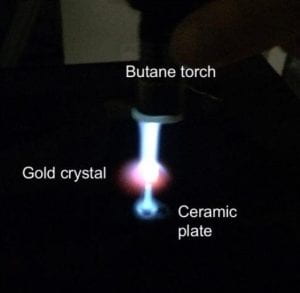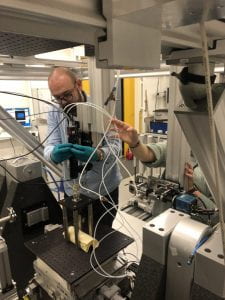Research

Electrochemical interfaces lie at the heart of and impact all electrochemical devices. Our group combines several disciplines: fundamental electrochemistry, materials science, surface science, data science and physics to help us learn the secrets of these interfaces so that we can create and control new and better electrochemical technologies. We sit on the edge of chemistry/physics using lasers, synchrotrons and ultra-high vacuum technologies.
| Harlow Group May 2025. |
 |
| Left to right: Aden (undergrad), Kalea*, Iqra*, Collin (PhD student), Yiduo*, Gary, Ziyan (PhD student), Tingting (visiting researcher). *OCE Masters Student |
Research:
| Advanced x-ray and neutron instrumentation/techniques
|
Electrochemical interfaces don’t remain static, they dynamically restructure with potential and electrolyte composition, therefore it’s important to be able to measure them under reaction conditions. We are experts in in situ surface x-ray diffraction, a grazing x-ray technique that allows surface structures to be determined with sub-angstrom precision. Prof. Harlow has developed the HAT software package for data treatment of high-energy surface x-ray diffraction data. He has also build several in situ cells, worked with grazing incidence XAFS, coherent Bragg diffraction, and in situ XPS. |
Single crystal electrochemistry |
Using single crystals we can investigate how individual crystal facets affect overpotentials, reaction kinetics and the products produced. Single crystal work is time consuming and requires a great deal of care and expertise. All our glassware and electrochemical cells are thoroughly cleaned in acids or similar solutions and the electrodes are prepared either via flame annealing, ultra-high vacuum sputtering/annealing, chemical etching or induction heating. We are currently building a combined UHV/electrochemistry transfer system for the ultimate control of our surface chemistry. |
| Molecular modifications of electrodes
|
When organic species interact with metal electrode surfaces and covalently bond the the metal electronic structure and the resulting functionality can be potentially tailored to our advantage. Ligands on the adsorbed molecules can also affect reaction pathways/kinetics and solvation structures. We are using highly controlled single crystal electrochemical studies combined with laser-induced temperature jump measurements, surface x-ray diffraction, and in situ spectroscopy to understand how we can best utilize metal molecule interactions. |
| Liquid structure at electrode interfaces
|
Using specular surface x-ray diffraction we can measure the electron density across the electrochemical interface. This is dominated by the electrode, but by also measuring non-specular rods, different electrolyte concentrations and using strongly scattering cations we can gain enough contrast to achieve fundamental insights into the structure of the electrochemical double layer. |
| Model studies of surface alloys and oxides in electrocatalysis
|
We work with international collaborators to synthesis well defined surface oxides relevant for water splitting via molecular beam epitaxy and other techniques and then characterize their atomic structure in situ at the synchrotron using high-energy surface X-ray diffraction. |
Hierarchical Nanostructures |
We are working on using templates for electrodeposition to build new catalyst structures that would be otherwise impossible, these catalysts can be important for CO2 reduction, electrolysis or many other reactions. |
Funding
We are grateful for support from the U.S. Department of Energy Basic Energy Sciences.



